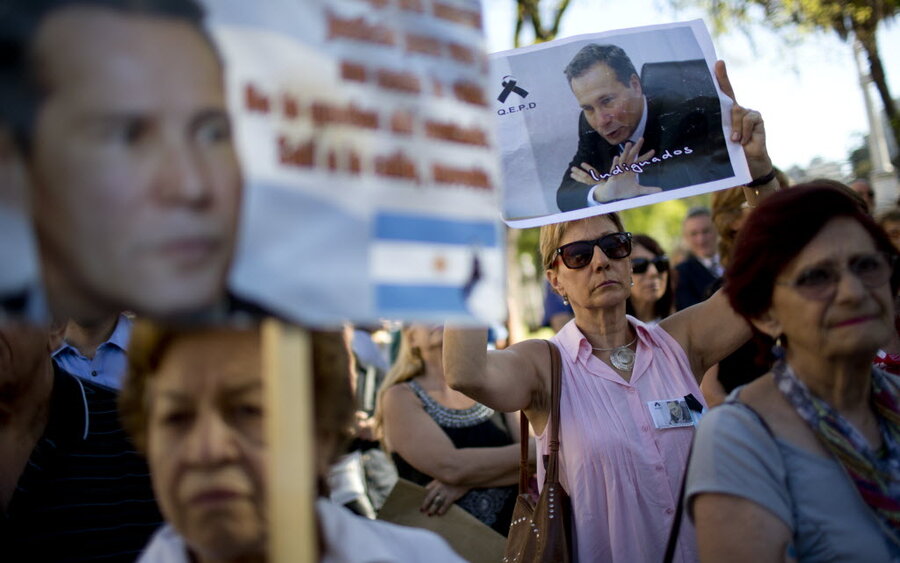In wake of Argentine prosecutor's death, a tangled web of questions
| Buenos Aires, Argentina
A series of revelations has jolted supporters of the dead prosecutor who accused Argentine President Cristina Kirchner of conspiring to cover up the deadly 1994 bombing of a Jewish center here.
Prosecutor Alberto Nisman was found dead at home with a single bullet in his temple on Jan. 18. That same day he was due to testify in Congress about his investigation into President Kirchner’s dealings with Iran, which had been accused of plotting the 1994 attack on the Argentine Israelite Mutual Association, or AMIA. His death – initially called a suicide – stoked conspiracy theories and has dented Argentines’ already low confidence in their institutions and leaders.
Now an apparent smear campaign against Nisman has cast a shadow over his character and his allegiances. Adding to the swirl of claims and counterclaims, his former wife said Wednesday that she had found Nisman's own gun in a storage area and that this supported the theory that it wasn't a suicide.
Nisman's unsolved death has cast a pall over presidential elections slated for the end of October, in which Kirchner won’t be running because of term limits. But voters so far seem focused on which candidate can revive a weak domestic economy; few believe that the case that Nisman was pursuing will ever come to light.
"There's no chance at all" that justice will be served, says Julieta Romero, a retiree, as she waited for a taxi. "They are all corrupt - the government, the prosecutors, the lawyers, the judges."
The biggest victim of the stalled investigation, and Nisman’s mysterious death, may be Argentines' faith in their leaders. At the end of February, over 70 percent of residents polled by political consultants Management & Fit said they have no expectation the case will ever be solved.
“It’s very likely that this will never be solved, and this of course leads huge skepticism in the justice system, institutions, in democracy,” said Carlos De Angelis, a sociology professor at the University of Buenos Aires.
Dueling judicial probes of unsolved death
After Nisman was found dead on the bathroom floor of his luxury apartment in downtown Buenos Aires, officials initially indicated that it was likely a suicide. Amid public outrage and accusations that the government was somehow involved, officials backtracked; days later, the president said via Facebook that she was convinced that Nisman had not killed himself.
From that point things only got murkier. While an official investigation led by a judge has yet to release its findings, Nisman’s ex-wife Sandra Arroyo Salgado, also a federal judge, said her own forensic study found that the prosecutor had been murdered, based on the angle of the bullet entry and other evidence.
Then came a series of revelations casting doubt on Nisman's character. Last month, pictures were leaked showing the prosecutor cavorting with beautiful young women on the beach and at luxurious parties. Then Nisman’s former computer assistant Diego Lagomarsino told the investigating judge that he shared an offshore joint account with Nisman and had given the prosecutor half of his 40,000 peso ($4,500) salary each month. Given Argentina’s reputation for corruption, this fueled suspicion that Nisman was skimming his investigation's large budget. Mr. Lagomarsino, who isn't a suspect in the case, has said he gave Nisman the 22-caliber gun used in his death.
Meanwhile, the explosive charges leveled by Nisman against Kirchner’s government – that she cut a trade deal with Iran in return for burying evidence of its embassy’s role in the 1994 terror attack – have largely fizzled out. Two courts have dismissed the case for lack of merit; an appeal is pending before a federal court.
The judges who dismissed the charges found there were no grounds to implicate the president and that the evidence – based largely on wire-tapped phone conversations of Argentine political operatives linked to Kirchner and Iranian representatives.
Spymaster loses his job
Questions also remain over the source of those recordings. Just a month before Nisman’s death, the president dismissed Antonio Stiusso, the head of Argentina’s powerful spy agency. Government officials have said that Mr. Stiusso manipulated Nisman into filing the charges. Stiusso’s replacement, Oscar Parrilli, has since filed charges against the former spy chief for hiding information related to the AMIA investigation, as well as smuggling and tax evasion.
The murky scandal adds to the frustration of those seeking accountability for the 1994 AMIA bombing that killed 85 and injured hundreds more. Two years earlier, the Israeli embassy here was also bombed; neither incident has been fully explained.
Kirchner’s husband, former President Nestor Kirchner, tasked Nisman in 2004 with leading the investigation. Nisman accused Iran of backing Hezbollah in carrying out the AMIA attack and convinced INTERPOL to issue a red notice seeking extradition against a half dozen former and current Iranian officials for their alleged participation. Iran has repeatedly denied any involvement. Nisman’s investigation later moved onto the president and members of her inner circle who were allegedly parties to a cover-up.
Still some here remain optimistic. "At some point the truth has to come out," said Federico Altgnug, an administrative assistant as he sat eating his lunch in a downtown park. "Not just what happened with Nisman, but what was behind his suicide or killing."





